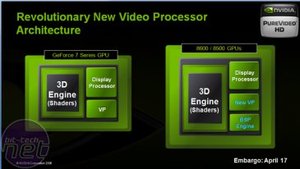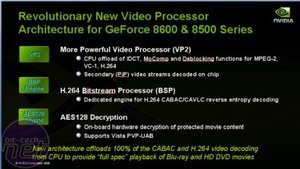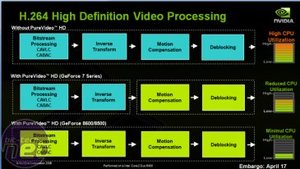New PureVideo Engine:
In addition to improving some of the G8x shading capabilities in G84 and G86, Nvidia has also introduced a new video processing engine, dubbed Video Processor 2 (VP2). Given its name, it won’t come as much of a surprise for us to tell you that it is Nvidia’s second generation video processing engine.It builds on Nvidia’s GeForce 7-series video processing engine (that is also featured in G80), which is capable of video decode acceleration and advanced post processing techniques. In addition, the video processing engine in G84 and G86 enables CPU usage to be reduced quite dramatically in H.264 movies with high bit rates of up to 40Mbps.
The H.264 and VC-1 video codecs are used in Blu-ray and HD DVD movies, so it should allow end users to play back HD movies smoothly on very affordable graphics hardware. That is, of course, providing HDCP is supported by the graphics card if the media requires it – we’ll come to that issue shortly.
VP2 features a programmable SIMD (single instruction, multiple data) processor whose flexibility enables it to be expanded upon in the future. It also allows typically very intensive video processing to be offloaded from the CPU onto the GPU. Because VP2 is a dedicated video processor, it should also mean that video processing is a more efficient task when it’s handled by the GPU, thus reducing overall system power consumption during HD video playback.
In order to achieve this, Nvidia has implemented a set of dedicated video processing engines integrated onto the same piece of silicon as the 3D engine – this is the same as with VP1, but with VP2, Nvidia has also included a dedicated H.264 bitstream processor and a dedicated AES128 Decryptor too.
The bitstream processor (BSP) has been specifically designed to accelerate two H.264 reverse entropy coding schemes known as Context Adaptive Variable Length Coding (CAVLC) and Context Adaptive Binary Arithmetic Coding (CABAC). These two tasks are very heavy on the CPU in a purely software environment – this is especially true with CABAC.
The second addition is the AES128 engine, which accelerates the decode of the AES128 encryption protocol required by video content security schemes like Advance Access Content System (AACS) and the Windows Vista Media Foundation. Both of these schemes require video data (both compressed and uncompressed) to be encrypted when it is sent over a User Accessible Bus (UAB), like PCI-Express. This feature was obviously implemented to keep the content providers happy moving forwards.
These two features combined allow the new Video Processor 2 engine to completely offload H.264 decoding from the CPU – a first in the PC video space. Because VP2 is able to accelerate all four stages of the H.264 decoding process, you should see good improvements over previous graphics hardware from both ATI and Nvidia, not forgetting CPUs too, of course.
Currently, the driver is only available on Windows Vista, and due to some unforeseen personal circumstances, I’m completing this review outside of our normal testing labs meaning that all of our testing was done using Windows XP Professional. Nvidia says that it expects to release a VP2 enabled driver for Windows XP in June this year. Rest assured though, as we will be coming back to revisit this on Windows Vista once normal service resumes in our labs.

MSI MPG Velox 100R Chassis Review
October 14 2021 | 15:04













Want to comment? Please log in.